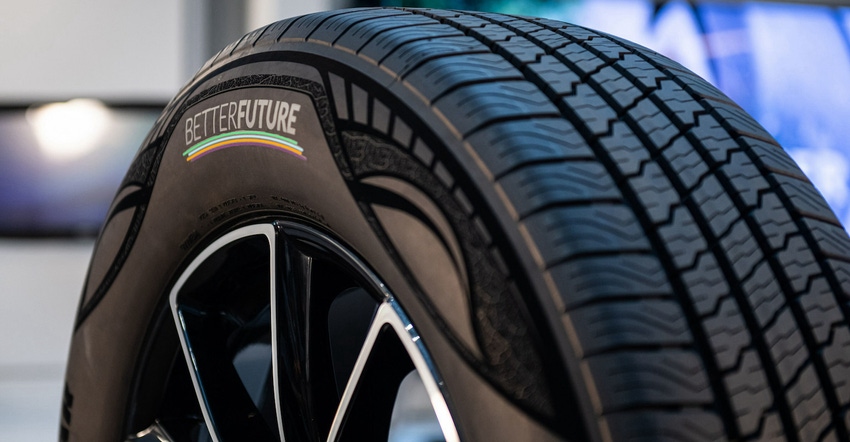Goodyear plans to market tires with up to 70% sustainable-material content this year.
January 6, 2023

The Goodyear Tire & Rubber Co. has unveiled a demonstration tire containing 90% sustainable materials, including raw material based on PET bottles. The demo tire has passed all applicable regulatory requirements as well as Goodyear's internal testing. In addition, after announcing the capability to demonstrate a 70% sustainable-material tire in January 2022, Goodyear, working with its supply base, plans to sell a tire with up to 70% sustainable-material content in 2023. Bringing a 90% sustainable-material tire to market will require further collaboration with the company's supply base to identify the scale necessary for these innovative materials to produce the tire at high volumes.
The demonstration tire was shown to have lower rolling resistance compared with the reference tire made with traditional materials. Lower rolling resistance means it has the potential to offer better fuel savings and a reduction in the carbon footprint.
While drivers normally associate tires solely with rubber, their makeup is complex and includes resin-based components. Goodyear’s 90% sustainable-material demonstration tire includes 17 featured ingredients across 12 different components.
Polyester is recycled from post-consumer bottles by converting the polyester into base chemicals and reformulating them into technical-grade polyester used in tire cords.
ISCC-certified mass balance polymers from bio- and bio-circular feedstock are included in this tire.
Resins are used to improve and enhance tire traction. In the demonstration tire, traditional petroleum-based resin is replaced with bio-renewable pine tree resin.
Carbon black, which is included in tires for compound reinforcement and to help increase their life span, is traditionally made by combusting various types of petroleum products. Goodyear's 90% sustainable-material demonstration tire features four different types of carbon black that are produced from methane, carbon dioxide, plant-based oil, and end-of-life tire pyrolysis oil feedstocks. These carbon black technologies target reduced carbon emissions, circularity, and the use of bio-based carbons, while still delivering on performance.
The use of soybean oil in this demonstration tire helps keep the tire's rubber compound pliable under changing temperatures. Soybean oil is a bio-based resource that helps to reduce Goodyear's use of petroleum-based products. While nearly 100% of soy protein is used in food/animal feed applications, a significant surplus of oil is left over and available for use in industrial applications.
Silica is an ingredient often used in tires to help improve grip and reduce fuel consumption. This demonstration tire includes high-quality silica produced from rice husk waste residue (RHA silica), a byproduct of rice processing that is often discarded and sent to landfills.
Today, eight Goodyear product lines and some racing tires include soybean oil. In addition, Goodyear has more than doubled its use of RHA silica in its product lines since 2018. With the introduction of a tire with up to 70% sustainable-material content, Goodyear said it is demonstrating a tangible commitment with in-market solutions to building a better future.
"We continue to make progress toward our goal of introducing the first 100% sustainable-material tire in the industry by 2030," said Chris Helsel, Senior Vice President, Global Operations, and Chief Technology Officer. "The past year was a pivotal one toward achieving this goal. We researched new technologies, identified opportunities for further collaboration, and utilized our team's tenacity not only to demonstrate our capabilities to produce a 90% sustainable-material tire, but also to produce a tire with up to 70% sustainable-material content this year. Our team continues to showcase its innovation and commitment to building a better future," said Helsel.
You May Also Like


